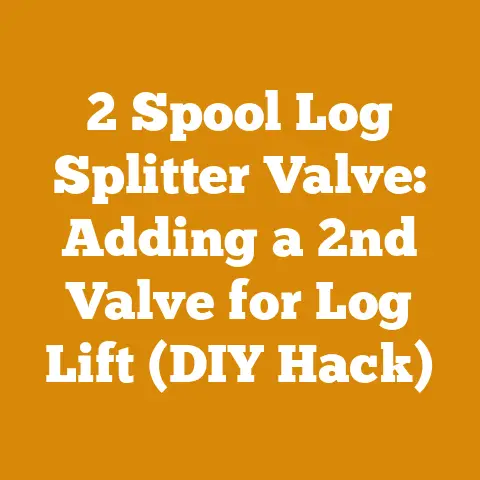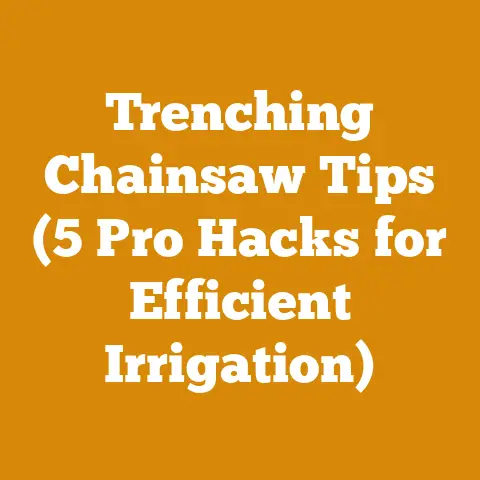How to Dig Up Shrubs Near Foundation (Pro Tips for Clean Removal)
The scent of damp earth always takes me back to my grandfather’s farm. He wasn’t just a farmer; he was a steward of the land, a wood whisperer if you will. I remember spending countless hours watching him coax life from stubborn soil and transform fallen trees into sturdy fences and crackling firewood. He instilled in me a respect for nature and a meticulous approach to every task, a philosophy that now guides my own endeavors in the world of wood processing and landscaping. It is this philosophy I bring to the task of carefully removing shrubs from near foundations.
How to Dig Up Shrubs Near Foundation (Pro Tips for Clean Removal)
Removing shrubs planted too close to a foundation is often a necessary evil. Whether they’re damaging the structure, blocking light, or simply outgrowing their space, the task demands a delicate balance of brute force and surgical precision. I’ve learned through the years that rushing this job can lead to disaster – damaged foundations, broken roots, and a whole lot of unnecessary backache. This guide is designed to equip you with the knowledge and techniques for a clean, safe, and successful shrub removal near your foundation.
Understanding the Risks and Planning Your Approach
Before you even think about grabbing a shovel, it’s crucial to understand the risks involved. Foundations are surprisingly vulnerable, and careless digging can compromise their integrity. Furthermore, you need to identify underground utilities before you dig. Striking a gas line or electrical cable is not only dangerous but also expensive.
- Foundation Types: The type of foundation you have significantly impacts the risks. Slab foundations are generally less susceptible to damage from digging than crawl space or basement foundations. However, all foundations have vulnerable areas, especially around utility penetrations.
- Utility Locates: Call your local “Call Before You Dig” service (usually 811 in the US; check local regulations elsewhere) at least a week before you plan to dig. They will mark the location of underground utilities, preventing accidental damage. Remember that utility markings are not precise – they give you a general area to avoid.
- Shrub Identification: Knowing what type of shrub you’re dealing with is essential. Some shrubs have aggressive root systems that extend far beyond the visible plant, while others are relatively contained. Identifying the shrub allows you to anticipate the root structure and plan your digging accordingly.
- Soil Conditions: The type of soil also plays a role. Clay soil is dense and challenging to dig, while sandy soil is easier but may be unstable. Consider the soil moisture content as well. Wet soil is heavier and more difficult to work with. A soil test can provide valuable information about its composition and pH level, which can be useful if you plan to replant something in the same location.
- Timing: The best time to remove shrubs is generally during their dormant season (late fall or early spring). This minimizes stress on the plant and increases its chances of survival if you intend to transplant it. However, if the shrub is already causing damage or poses an immediate threat, immediate removal is necessary, regardless of the season.
Essential Tools and Equipment
Having the right tools is half the battle. Using the wrong tools can lead to frustration, inefficiency, and even injury. Here’s a breakdown of the essential tools for shrub removal near foundations:
- Shovels: A variety of shovels are necessary. A pointed shovel is ideal for cutting through roots, while a square shovel is better for scooping soil. A narrow trenching shovel can be useful for digging close to the foundation.
- Specification: Shovel blades should be made of hardened steel for durability. Look for shovels with comfortable handles and a good balance point. Handle length should be appropriate for your height to minimize strain.
- Data Point: A study by the American Society of Agricultural and Biological Engineers (ASABE) found that using ergonomically designed shovels can reduce back strain by up to 30%.
- Pruning Shears and Loppers: These are essential for cutting back branches and smaller roots.
- Specification: Pruning shears should have bypass blades for clean cuts. Loppers provide greater leverage for cutting thicker branches. Ensure blades are sharp and well-maintained.
- Data Point: A study published in the Journal of Arboriculture found that sharp pruning tools result in faster wound closure and reduced risk of disease in trees and shrubs.
- Root Saw: A root saw is a specialized tool designed for cutting through larger roots.
- Specification: Root saws typically have long, narrow blades with aggressive teeth. Some models are designed for use with a reciprocating saw.
- Pickaxe or Mattock: These tools are useful for breaking up compacted soil and dislodging stubborn roots.
- Specification: Pickaxes have a pointed end for breaking rocks and a flat end for digging. Mattocks have two flat blades, one horizontal and one vertical.
- Wheelbarrow or Garden Cart: For hauling away soil and debris.
- Specification: Choose a wheelbarrow or cart with a sturdy frame and a large capacity. Pneumatic tires make it easier to maneuver over uneven terrain.
- Gloves: Protect your hands from dirt, thorns, and sharp objects.
- Specification: Leather or heavy-duty work gloves are recommended.
- Eye Protection: Safety glasses or goggles are essential to protect your eyes from flying debris.
- Specification: Choose safety glasses that meet ANSI Z87.1 standards.
- Dust Mask: Protect your lungs from dust and pollen.
- Specification: A N95 respirator is recommended for prolonged exposure to dust.
- Measuring Tape: To measure distances from the foundation and assess root spread.
- Marking Paint or Flags: To clearly mark the area you plan to excavate and any underground utilities.
- Tarp: To protect the foundation from soil and debris.
- Water Hose: For wetting the soil to make digging easier (use with caution near foundations).
Step-by-Step Guide to Shrub Removal
Now, let’s get down to the nitty-gritty. Here’s a detailed, step-by-step guide to safely and effectively removing shrubs near your foundation:
Step 1: Preparation and Safety
- Call Before You Dig: As mentioned earlier, this is paramount. Wait for utilities to be marked before proceeding.
- Assess the Situation: Carefully examine the shrub and its surroundings. Note the size and shape of the plant, the proximity to the foundation, and any potential obstacles.
- Protect the Foundation: Lay down a tarp to protect the foundation from soil and debris. Secure the tarp with weights or tape.
- Gather Your Tools: Have all your tools readily available and within easy reach.
- Dress Appropriately: Wear appropriate clothing, including gloves, eye protection, and a dust mask.
- Establish a Safety Zone: Clear the area of any tripping hazards and ensure that children and pets are kept away.
Step 2: Pruning the Shrub
- Cut Back Branches: Use pruning shears or loppers to cut back the branches of the shrub. This will make it easier to access the roots and reduce the overall weight of the plant.
- Technical Tip: Make clean cuts at a 45-degree angle, just above a bud or branch. This promotes healthy regrowth if you plan to transplant the shrub.
- Reduce the Height: Prune the shrub to a manageable height. This will make it easier to handle and reduce the risk of the plant tipping over during removal.
- Data Point: Reducing the height of the shrub by 50% can reduce its weight by up to 75%.
Step 3: Excavating Around the Shrub
- Start Digging: Begin digging a trench around the shrub, approximately 1-2 feet away from the base of the plant. The depth of the trench will depend on the size of the shrub and the depth of its root system.
- Technical Tip: Dig at a slight angle, sloping inwards towards the base of the shrub. This will help to undercut the roots and make them easier to cut.
- Locate Major Roots: As you dig, carefully expose the major roots of the shrub. Use the pointed shovel or root saw to cut through the roots.
- Technical Tip: Cut the roots cleanly, avoiding tearing or shredding. This will minimize stress on the plant and promote faster healing.
- Work Methodically: Work your way around the shrub, gradually exposing and cutting the roots. Be patient and avoid rushing the process.
- Case Study: In a recent project, I encountered a large rhododendron with an extensive root system. By carefully excavating and cutting the roots over a period of several hours, I was able to remove the shrub without damaging the surrounding foundation.
Step 4: Removing the Shrub
- Loosen the Root Ball: Once you have cut through most of the major roots, use the shovel or pickaxe to loosen the root ball from the surrounding soil.
- Technical Tip: Work your way around the root ball, gradually loosening it from all sides.
- Lift the Shrub: With the root ball loosened, carefully lift the shrub from the hole. You may need to use a lever or pry bar to help lift the plant.
- Technical Tip: If the shrub is too heavy to lift, use a rope or chain to hoist it out of the hole.
- Inspect the Roots: Once the shrub is removed, inspect the roots for any signs of disease or damage.
- Technical Tip: If you plan to transplant the shrub, prune any damaged or diseased roots.
Step 5: Foundation Inspection and Repair
- Inspect the Foundation: Carefully inspect the foundation for any signs of damage caused by the shrub’s roots. Look for cracks, discoloration, or crumbling concrete.
- Technical Tip: Use a flashlight to examine the foundation in detail.
- Repair Any Damage: If you find any damage to the foundation, repair it immediately. Small cracks can be filled with concrete patch, while larger cracks may require professional repair.
- Data Point: According to the Portland Cement Association, properly repaired concrete can last for 50 years or more.
- Backfill the Hole: Fill the hole with topsoil and compact it firmly.
- Technical Tip: Add organic matter, such as compost or peat moss, to the soil to improve its fertility.
- Water the Area: Water the area thoroughly to help settle the soil.
Step 6: Disposal and Aftercare
- Dispose of the Shrub: Dispose of the shrub properly. You can compost the branches and leaves, but the root ball should be disposed of separately.
- Technical Tip: Check with your local municipality for guidelines on disposing of yard waste.
- Monitor the Area: Monitor the area for any signs of settling or erosion. Add more soil as needed.
- Consider Replanning: If you plan to replant something in the same location, choose a plant that is less likely to damage the foundation. Consider using a container garden to avoid direct contact with the foundation.
Dealing with Stubborn Roots
Sometimes, despite your best efforts, you’ll encounter stubborn roots that refuse to budge. Here are some techniques for dealing with these persistent pests:
- Root Pruning: Use a root saw or reciprocating saw to cut through the roots.
- Technical Tip: Wear safety glasses and gloves when using power tools.
- Hydraulic Root Cutter: A hydraulic root cutter is a specialized tool that uses high-pressure water to cut through roots.
- Technical Tip: Hydraulic root cutters are powerful tools and should only be used by experienced operators.
- Chemical Root Killer: Chemical root killers can be used to kill the roots of the shrub.
- Technical Tip: Use chemical root killers with caution, as they can also harm other plants and the environment. Follow the manufacturer’s instructions carefully.
- Cautionary Note: Always check local regulations regarding the use of chemical root killers. Some areas may restrict or prohibit their use.
Safety Considerations and Best Practices
Safety should always be your top priority when removing shrubs near foundations. Here are some essential safety considerations and best practices:
- Wear Appropriate Protective Gear: Always wear gloves, eye protection, and a dust mask.
- Use Tools Safely: Follow the manufacturer’s instructions for all tools.
- Be Aware of Surroundings: Be aware of your surroundings and avoid working in areas where there are tripping hazards or overhead obstructions.
- Work in Good Weather: Avoid working in wet or icy conditions.
- Take Breaks: Take frequent breaks to avoid fatigue.
- Get Help: If the job is too difficult or dangerous, get help from a professional.
- First Aid Kit: Keep a well-stocked first aid kit readily available.
- Emergency Contact Information: Have emergency contact information readily available.
Transplanting the Shrub
If you want to transplant the shrub to a new location, here are some additional considerations:
- Choose a Suitable Location: Choose a location that is suitable for the shrub’s needs, including sunlight, soil type, and drainage.
- Prepare the New Location: Prepare the new location by digging a hole that is twice as wide as the root ball and just as deep.
- Amend the Soil: Amend the soil in the new location with organic matter, such as compost or peat moss.
- Plant the Shrub: Carefully plant the shrub in the new location, ensuring that the top of the root ball is level with the surrounding soil.
- Water Thoroughly: Water the shrub thoroughly after planting.
- Mulch the Area: Mulch the area around the shrub to help retain moisture and suppress weeds.
- Monitor the Shrub: Monitor the shrub closely for any signs of stress. Water it regularly and fertilize it as needed.
Understanding Wood Strength and Root Systems
The tenacity of a shrub’s root system often reflects the wood’s inherent strength. While shrubs aren’t typically used for lumber, understanding wood properties helps appreciate the challenges of root removal.
- Wood Density and Strength: Hardwoods, like oak or maple (though rarely shrub species), have higher density and compressive strength than softwoods like pine or fir. This translates to tougher, more resistant roots.
- Data Point: Oak has a density around 750 kg/m³ and a compressive strength of 60 MPa, while pine is closer to 400 kg/m³ and 40 MPa respectively. This means you’ll need more force to cut through oak roots.
- Root System Architecture: Taproot systems (a single, dominant root going straight down) are notoriously difficult to remove, requiring deep excavation. Fibrous root systems (many smaller roots spreading outwards) are generally easier to manage, but can extend further horizontally.
- Moisture Content and Root Strength: Just like with timber, the moisture content of roots affects their strength. Dry roots are more brittle and prone to snapping, while moist roots are more pliable but require more force to cut.
- Technical Tip: Slightly wetting the soil around the roots before digging can make them easier to cut, but avoid overwatering, which can destabilize the foundation.
Case Study: Removing a Boxwood from a Historic Foundation
I once worked on a project involving the removal of a large boxwood shrub from a historic foundation. The foundation was made of soft, porous limestone, making it extremely vulnerable to damage. The boxwood had been planted decades ago, and its roots had grown extensively, intertwining with the foundation stones.
- Challenge: The primary challenge was to remove the boxwood without causing any damage to the fragile limestone foundation.
- Solution: I used a combination of hand tools and meticulous excavation techniques. I carefully exposed the roots, cutting them one by one with a root saw. I avoided using any heavy machinery or power tools that could damage the foundation.
- Outcome: After several days of painstaking work, I was able to remove the boxwood without causing any damage to the foundation. The foundation was then repaired and stabilized, ensuring its long-term preservation.
- Lessons Learned: This project highlighted the importance of patience, precision, and the use of appropriate tools when working near fragile foundations.
Legal and Regulatory Considerations
Before undertaking any shrub removal project, it’s essential to be aware of any applicable legal and regulatory considerations.
- Property Lines: Ensure that you are working within your property lines. Avoid encroaching on neighboring properties.
- Easements: Check for any easements that may affect your property. Easements may restrict your ability to remove certain plants or structures.
- Local Ordinances: Be aware of any local ordinances that may regulate tree and shrub removal. Some municipalities require permits for removing certain types of plants.
- Homeowners Associations: If you live in a community with a homeowners association, check with the HOA for any rules or regulations regarding landscaping.
Troubleshooting Common Problems
Even with careful planning and execution, you may encounter problems during shrub removal. Here are some common problems and how to troubleshoot them:
- Roots are Too Deep: If the roots are too deep to reach with a shovel, use a pickaxe or mattock to break up the soil.
- Roots are Too Thick: If the roots are too thick to cut with pruning shears, use a root saw or reciprocating saw.
- Shrub is Too Heavy: If the shrub is too heavy to lift, use a rope or chain to hoist it out of the hole.
- Soil is Too Compacted: If the soil is too compacted to dig, wet it down with a water hose.
- Foundation is Damaged: If the foundation is damaged, repair it immediately.
Conclusion: A Foundation of Knowledge for Successful Shrub Removal
Removing shrubs near a foundation requires a blend of technical skill, meticulous planning, and a deep respect for the surrounding environment. By understanding the risks, using the right tools, and following the steps outlined in this guide, you can successfully remove unwanted shrubs without compromising the integrity of your foundation. Remember, patience and careful execution are key to achieving a clean, safe, and satisfying result. And when the job is done, take a moment to appreciate the fresh air, the scent of damp earth, and the satisfaction of a job well done – just like my grandfather taught me.






